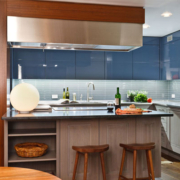Eco-Friendly Woodwork: Master Carpentry in Sustainable Homes
Sustainability is no longer an afterthought in modern design—it’s a priority. Homeowners are asking smarter questions, architects are specifying better materials, and contractors are rethinking old habits. And one of the most impactful changes is happening in the world of carpentry. More than just cutting wood and building furniture, eco-friendly woodwork is now a core element in creating healthier, longer-lasting, and more responsible homes.
At Nest Inc., we see sustainability not as a feature, but as a foundation. Through expert interior contract services and custom woodwork, we’re helping clients build beautiful spaces that respect both craftsmanship and the environment.
Let’s explore how sustainable carpentry and thoughtful design can come together to shape homes that are not only stylish but also smarter for the planet.
What Is Eco-Friendly Woodwork?
Eco-friendly woodwork refers to carpentry practices and materials that minimize environmental impact without compromising design or durability. It involves everything from how the wood is sourced to how it’s treated, installed, and maintained.
Sustainable woodwork often includes:
- FSC-certified lumber from responsibly managed forests
- Reclaimed wood from old buildings, barns, or industrial sites
- Non-toxic finishes that keep indoor air quality safe
- Durable joinery that ensures pieces last decades, not years
- Minimal waste practices during design and construction
In short, it’s not just about using wood—it’s about using wood well.
Why Sustainable Carpentry Is More Important Than Ever
Wood has always been a preferred material in interior design and construction. It’s strong, warm, versatile, and timeless. But traditional woodworking can come with a cost: deforestation, chemical emissions, and excess waste.
That’s where sustainable carpentry comes in. By focusing on responsible sourcing and cleaner production, this approach helps protect forests, reduce carbon footprints, and create healthier home environments. And with climate change and indoor air quality becoming growing concerns, homeowners now expect their living spaces to be both beautiful and responsible.
Eco-friendly woodwork also supports the idea of long-term value. Custom cabinetry, trim, and built-ins made with care won’t need replacing after just a few years. That durability, paired with sustainability, is what makes it such a powerful approach to modern homebuilding.
Interior Contract Work That Puts Sustainability First
Sustainability isn’t just about materials—it’s also about execution. A skilled interior contractor who understands green building principles can make a major difference in the outcome of your space.
At Nest Inc., we specialize in high-end interior contracting with a sustainable lens. When working with clients on kitchen renovations, custom millwork, or whole-home upgrades, we prioritize materials and methods that reflect our commitment to eco-conscious craftsmanship.
That means sourcing wood from verified suppliers, recommending low-VOC finishes, and designing with longevity in mind. Whether we’re building a custom closet or full wall paneling, our carpenters work with intention, choosing techniques that last and reduce waste.
Where Eco-Friendly Woodwork Shines in the Home
You can incorporate eco-conscious carpentry in nearly every room of your home. Here are some of the most common—and high-impact—applications:
Kitchens
Cabinetry is often the biggest investment in a kitchen remodel. Choosing FSC-certified hardwoods or bamboo, along with formaldehyde-free plywood and water-based finishes, can significantly lower your environmental impact. Built to fit your space, custom cabinets also reduce the need for fillers or wasteful materials.
Living Rooms
Think of all the wood elements in your living area: floating shelves, mantels, bookcases, and entertainment centers. When built with reclaimed or sustainable wood, these features not only add charm, they tell a story and reduce demand for new lumber.
Bedrooms and Closets
Built-in wardrobes, nightstands, and dressers are prime opportunities to use clean, sustainable materials. Because these pieces are often near sleeping areas, non-toxic stains and finishes are especially important for indoor air quality.
Home Offices
In today’s hybrid world, many people are investing in permanent work-from-home spaces. Desks, shelving, and paneling made from eco-friendly wood offer both function and focus without compromising on environmental ethics.
The Art of Master Carpentry in a Sustainable World
Good carpentry has always been an art form. It requires skill, precision, and a deep understanding of materials. But in a sustainable context, it also requires intent—the commitment to think not just about how something looks, but how it performs and what impact it has long-term.
Master carpenters understand how to work with reclaimed wood, which may have imperfections but also character. They know how to build without excess. They create joinery that holds up without heavy reliance on harmful adhesives. And most of all, they treat wood as a resource, not a shortcut.
At Nest Inc., our in-house craftspeople work with this mindset every day. We pair traditional techniques with modern innovation to deliver woodwork that’s both stunning and sustainable.
How to Know You’re Getting Truly Eco-Friendly Woodwork
The words “eco-friendly” and “sustainable” are thrown around a lot these days. Here’s how to ensure the work being done in your home truly lives up to those labels:
- Ask for certifications. Look for FSC or reclaimed wood documentation.
- Inquire about finished products. Your contractor should know if they’re using low-VOC stains and sealants.
- Discuss lifespan. Well-built woodwork should be measured in decades, not seasons.
- Request local sourcing. The closer your materials, the smaller the carbon footprint.
- Prioritize collaboration. The best sustainable results happen when your designer, builder, and interior contractor all work in sync.
With the right team, sustainability becomes second nature—and the results speak for themselves.
Sustainable Doesn’t Mean Sacrificing Style
Some homeowners worry that choosing eco-friendly materials might limit their design options. The truth is, it’s quite the opposite. Eco-friendly woodwork opens the door to textures, grains, and finishes that are incredibly rich and layered.
Reclaimed wood brings a rustic, lived-in feel. FSC-certified walnut or oak offers sleek, modern tones. Bamboo and cork introduce warmth and a touch of the unexpected. Whether your aesthetic leans traditional, minimalist, or ultra-modern, sustainable carpentry can support it.
The secret lies in the execution, and that’s where hiring the right interior contract team becomes essential.
The Future of Homebuilding Is Thoughtful
We believe that building better homes starts with asking better questions. How was this material made? How long will it last? What kind of environment will it create?
When you prioritize eco-friendly woodwork and sustainable carpentry, you’re not just making a design choice. You’re investing in the future of your home, your family, and the planet.
Whether you’re remodeling a single room or building from the ground up, sustainability doesn’t have to be a challenge. With the right professionals, it becomes a natural part of the process, and the results are more meaningful and enduring than ever.
Let’s Build Eco-Friendly Woodwork
At Nest Inc., we specialize in eco-conscious interiors designed to elevate your space and protect the planet. From eco-friendly woodwork to full-scale interior contract services, our expert team brings care, craftsmanship, and sustainability to every project.
Ready to transform your home with sustainable carpentry and design? Request your free quote today and let’s build something that lasts.






